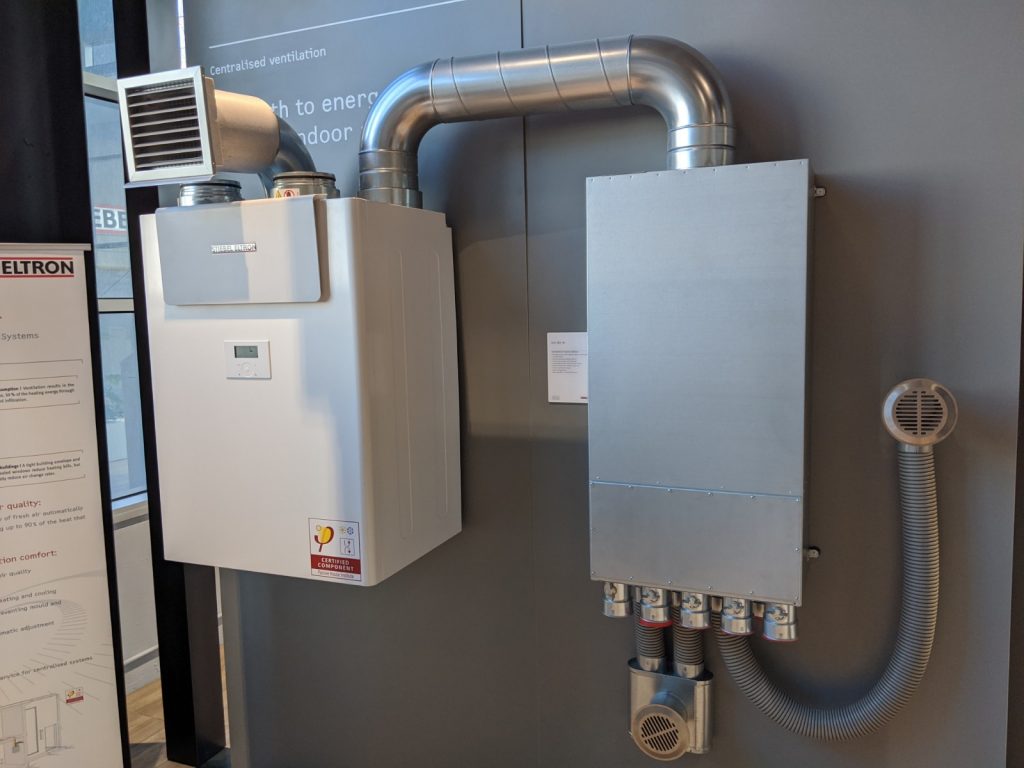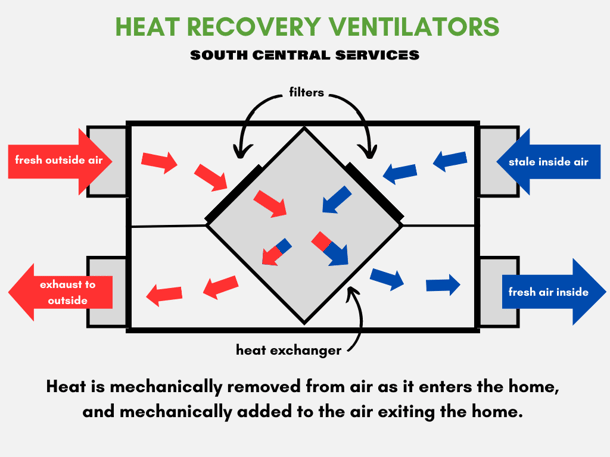The Comprehensive Guide to HRV Setup in Residential Spaces
Wiki Article
Revealing the Trick Conveniences and Uses of Heat Recovery Ventilation in Sustainable Layout
Heat Recovery Ventilation (HRV) systems play a necessary role in sustainable layout. They facilitate a continuous exchange of stale interior air with fresh exterior air, significantly enhancing interior air top quality. HRVs add to energy performance by redeeming heat from worn down air, which can reduce energy prices. Comprehending the diverse benefits and applications of HRVs discloses their importance in contemporary architecture. What other advantages do these systems provide in the pursuit of sustainability?Comprehending Heat Recovery Ventilation Solutions
Heat recovery ventilation (HRV) systems are created to improve interior air high quality while lessening power loss. These systems make use of a mechanical ventilation technique to exchange stale interior air with fresh outdoor air, making sure a continual supply of tidy air. By recording heat from the exhaust air, HRVs prerequisite inbound air, lowering the demand on home heating and cooling systems. This process not just improves thermal convenience but likewise adds to energy effectiveness in domestic and commercial structures. Additionally, HRV systems aid regulate moisture levels and decrease interior toxins, promoting a much healthier living environment. Their critical application is vital for accomplishing lasting style objectives, as they use a balance in between energy preservation and resident health.Just How HRV Solution Work
While several might know with ventilation systems, recognizing just how heat healing air flow (HRV) systems operate is crucial for appreciating their advantages. HRV systems function by trading stagnant indoor air with fresh exterior air while transferring warmth between both streams. This procedure occurs in a warmth exchanger, where heat from the outward bound air heats the inbound air during chillier months, reducing energy loss. Alternatively, in warmer months, the system can cool down incoming air utilizing the cooler outgoing air. HRVs are outfitted with followers to assist in airflow and filters to remove particulates, ensuring a continual, well balanced ventilation process. This cutting-edge style not only improves energy efficiency yet additionally adds to maintaining a comfy indoor setting.Enhancing Indoor Air Quality
Interior air high quality can significantly affect health and well-being, making efficient ventilation vital in contemporary homes. Heat Recovery Ventilation (HRV) systems play a crucial function in maintaining indoor air top quality by continuously trading stagnant indoor air with fresh outside air. This procedure not only lowers airborne toxins however also decreases moisture degrees, which can result in mold and mildew growth and breathing concerns. HRV systems filter inbound air, eliminating irritants and particulates, consequently providing a healthier living atmosphere. In addition, these systems aid remove smells and volatile natural substances (VOCs) frequently discovered in home products. By ensuring a regular flow of clean air, HRV systems contribute to an overall improved indoor atmosphere, advertising comfort and health for residents.Power Effectiveness and Price Cost Savings
Power efficiency stands apart as a significant benefit of Heat Recovery Ventilation (HRV) systems. By catching and recycling the heat from tired interior air, HRVs minimize the power required for heating inbound fresh air, resulting in decreased power consumption. This performance equates into lower energy expenses, offering considerable cost financial savings for house owners and organizations alike. In addition, HRV systems commonly get power efficiency incentives and discounts, additionally boosting their monetary allure. Over time, the first investment in HRV technology can bring about a favorable return on financial investment through reduced power expenditures. As a result, the combination of HRV systems not only promotes lasting style however additionally supplies a sensible remedy for accomplishing lasting energy financial savings and financial benefits.Environmental Advantages of HRV

A wide variety of environmental benefits occurs from the application of Heat Recovery Ventilation (HRV) systems. By effectively moving warm from exhaust air to inbound fresh air, HRVs significantly reduce the energy needed for home heating and cooling down areas. This power effectiveness converts to lower greenhouse gas emissions, adding to a reduction in the general carbon footprint of buildings. Additionally, HRV systems improve interior air top quality by constantly distributing fresh air, thus minimizing the concentration of indoor contaminants and allergens. In addition, the decrease in power intake help in preserving all-natural sources, making HRVs an important component of sustainable style. Generally, the environmental benefits of HRVs play a crucial function in advertising a much healthier planet and cultivating environment-friendly structure practices.
Versatile Applications in Modern Design
Heat recovery ventilation (HRV) systems are progressively being incorporated into both residential and business architectural tasks. In domestic setups, HRVs enhance interior air quality while optimizing energy performance. In industrial rooms, these systems maximize ventilation approaches, demonstrating their versatility in contemporary building applications.Residential Projects Assimilation
While modern design significantly emphasizes sustainability, the combination of warm recuperation ventilation systems in domestic jobs has actually arised as a useful option for boosting indoor air high quality and power performance. These systems efficiently transfer warm from exhaust air to inbound fresh air, minimizing energy loss and minimizing home HRV Heat Recovery Ventilation heating or cooling down needs. In new builds and retrofits alike, heat healing ventilation can be perfectly incorporated, supplying property owners with a much healthier living setting while decreasing energy prices. In addition, with raising understanding of ecological impacts, even more engineers and home builders are identifying the long-lasting benefits of these systems. Because of this, warmth healing air flow has ended up being an essential element of sustainable residential layout, showcasing convenience and commitment to environment-friendly techniques.Business Spaces Optimization
As modern commercial rooms evolve to fulfill the needs of sustainability and performance, the execution of warm recovery air flow systems becomes an essential strategy for maximizing indoor environments. These systems promote the exchange of stale interior air with fresh outdoor air while redeeming warm energy, substantially decreasing power consumption. This not just improves comfort for passengers yet also aids in reducing functional expenses. Versatile applications can be observed in workplaces, retail spaces, and universities, where air top quality and temperature control are paramount. Furthermore, incorporating warm recuperation ventilation lines up with green building qualifications, even more advertising ecological responsibility. Eventually, taking on such systems in commercial design not just contributes to sustainability goals yet also cultivates healthier, extra productive rooms for customers.
Integrating HRV Into Sustainable Style Practices
Incorporating warmth recovery ventilation (HRV) systems right into lasting layout practices offers considerable benefits in energy effectiveness and interior air high quality. By using HRV, designers can produce cost-efficient remedies that not just lower power consumption but likewise improve the total comfort of indoor environments. This alignment with sustainability goals settings HRV as an important element in contemporary architectural methods.
Power Performance Enhancement
By incorporating warm healing air flow (HRV) systems right into sustainable design practices, designers and contractors can significantly enhance energy effectiveness in contemporary buildings. HRV systems operate by catching warm from outward bound stagnant air and transferring it to inbound fresh air, reducing the power needed for home heating or cooling down interior rooms. This process not only decreases reliance on typical heating and cooling systems but additionally reduces general energy consumption. Furthermore, HRV systems can aid keep a constant indoor temperature, reducing peak energy needs. By integrating these systems, structures can accomplish considerable reductions in energy expenses and carbon impacts, lining up with sustainability objectives. Inevitably, HRV technology stands for a functional solution for boosting power efficiency in the developed atmosphere, advertising more liable resource usage.Indoor Air Quality Renovation
Exactly how can warm recuperation air flow (HRV) systems contribute to remarkable indoor air quality in contemporary buildings? HRV systems successfully exchange stale interior air with fresh exterior air while recovering heat, lessening temperature level variations. This process lowers the concentration of interior contaminants, such as unpredictable organic substances (VOCs), irritants, and dampness, which can wear away air top quality and influence owner health. By keeping perfect humidity levels and making sure a constant supply of clean air, HRVs help create a healthier interior setting. On top of that, these systems can be incorporated right into lasting style methods, promoting energy effectiveness together with boosted air top quality. HRV Heat Recovery Ventilation. HRV modern technology plays an essential role in progressing total resident convenience and health in contemporary architectural designs.Economical Layout Solutions

Frequently Asked Questions
What Maintenance Is Needed for Heat Recovery Ventilation Systems?

Upkeep for warm healing air flow systems typically involves routine filter substitutes, cleansing of warmth exchangers, inspection of fans and ducts, and making sure correct drain. These jobs help maintain efficiency and extend the system's life-span over time.
Can HRV Equipments Be Set Up in Existing Buildings?
Heat recovery ventilation systems can undoubtedly be mounted in existing buildings. HRV Heat Recovery Ventilation. Retrofitting calls for mindful planning and evaluation of the structure's format, ensuring compatibility with existing systems while maximizing power performance and interior air high qualityExactly How Do HRV Solution Impact Sound Degrees Inside Your Home?
HRV systems can affect indoor noise levels by presenting noise from outside resources via ventilation. Premium setups usually integrate sound-dampening attributes, decreasing sound influence while giving efficient air exchange and preserving comfort indoors.Exist Any Downsides to Using HRV Equipments?
The downsides of using HRV systems consist of prospective high preliminary prices, upkeep difficulties, and the possibility of reduced indoor air top quality if filters are sporadically changed, which can cause problems with humidity levels.Just how Do I Pick the Right HRV System for My Requirements?
Selecting the appropriate warm recovery ventilation system includes examining details demands, such as constructing dimension, climate, and power performance objectives. In addition, evaluating system attributes, installment demands, and upkeep factors to consider is necessary for peak performance and fulfillment.Report this wiki page